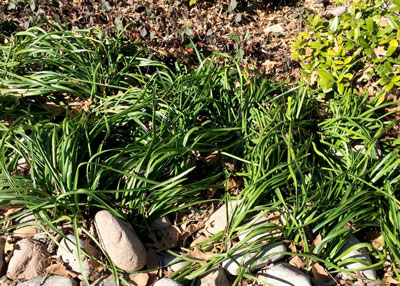Great Little Source of Fall Color: September 7, 2017
It was 1978. We were finishing construction on our new home outside McKinney, and we happened to drive by the small (then) McKinney airport. There was an old farmhouse there, obviously deserted, with a row of the most beautiful little red bulbs blooming proudly at its front door. Yet no one had tended to them for years.

Photo: Oxblood lilies resemble tiny amaryllis, but they bloom in September.
I got a photo and was soon able to identify them as oxblood lilies (Rhodophiala bifida), also known as schoolhouse lilies because of the time of year that they bloom. Soon thereafter that house was moved. The ground was paved over in an airport expansion, and the little bulbs were probably lost. But I was determined that I’d find some.
Jump ahead two years…
I was visiting the gardens of a daylily grower friend of mine in Mansfield, and I saw lush foliage that obviously wasn’t daylilies. I asked what it was, and bingo, there was my start of oxblood lilies, another great source of fall color. He dug up probably 25 bulbs, leaves and all, and they still bloom every September in a far spot in our gardens. (I need to move them up closer to the house.)
Not satisfied with that supply, I started looking on my old buddy eBay, and to my surprise, a lady in California was offering them for sale at a price far less than the rare bulb sources I’d found. That was three years ago. I bought those and we planted them right away. It was September, so I didn’t expect any flowers that year. They spent one more year establishing, and that second fall (last year), they were spectacular.

Photo: These blooms are from bulbs bought on eBay. Search “oxblood lilies,” but hurry – there were only six listings at “press time.”
These photos are from this year’s flowers, in bloom as you read this. They’re about 12 inches tall, and their flowers are the size of ping pong balls. Last year they bloomed two more times in September – on 15-day turnarounds! I had no idea they would do that. We’ll see how they perform this year, but even if there’s only one round of flowers, oxblood lilies are spectacular performers.

Oxblood lilies’ leaves don’t appear until they’ve finished flowering. They persist through winter and into late spring. Photo from Sperry landscape last January.
Their leaves come up after they bloom and they persist through the winter. By the time the trees leaf out, the leaves are dying back to the ground. Then the next thing you see is a big mass of flowers almost overnight. Ours receive no special water or fertilizer – just what they get when adjacent shrubs and groundcovers are fed once a year. No pests. No problems. Just joy.
Happy hunting. Hope you can find some, because I know you’ll love them as much as we do.

Photo: Nothing was visible in this bed one week ago today!
